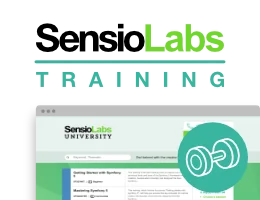User Providers
User providers (re)load users from a storage (e.g. a database) based on a "user identifier" (e.g. the user's email address or username). See Security for more detailed information when a user provider is used.
Symfony provides several user providers:
- Entity User Provider
- Loads users from a database using Doctrine;
- LDAP User Provider
- Loads users from a LDAP server;
- Memory User Provider
- Loads users from a configuration file;
- Chain User Provider
- Merges two or more user providers into a new user provider.
Entity User Provider
This is the most common user provider. Users are stored in a database and the user provider uses Doctrine to retrieve them.
1 2 3 4 5 6 7 8 9 10 11 12 13 14 15
# config/packages/security.yaml
security:
providers:
users:
entity:
# the class of the entity that represents users
class: 'App\Entity\User'
# the property to query by - e.g. email, username, etc
property: 'email'
# optional: if you're using multiple Doctrine entity
# managers, this option defines which one to use
#manager_name: 'customer'
# ...1 2 3 4 5 6 7 8 9 10 11 12 13 14 15 16 17 18 19 20 21 22 23
<!-- config/packages/security.xml -->
<?xml version="1.0" encoding="UTF-8" ?>
<srv:container xmlns="http://symfony.com/schema/dic/security"
xmlns:xsi="http://www.w3.org/2001/XMLSchema-instance"
xmlns:srv="http://symfony.com/schema/dic/services"
xsi:schemaLocation="http://symfony.com/schema/dic/services
https://symfony.com/schema/dic/services/services-1.0.xsd">
<config>
<provider name="users">
<!-- class: the class of the entity that represents users
property: the property to query by - e.g. email, username, etc-->
<entity class="App\Entity\User" property="email"/>
<!-- optional, if you're using multiple Doctrine entity
managers, "manager-name" defines which one to use -->
<!-- <entity class="App\Entity\User" property="email"
manager-name="customer"/> -->
</provider>
<!-- ... -->
</config>
</srv:container>1 2 3 4 5 6 7 8 9 10 11 12 13
// config/packages/security.php
use App\Entity\User;
use Symfony\Config\SecurityConfig;
return static function (SecurityConfig $security): void {
// ...
$security->provider('app_user_provider')
->entity()
->class(User::class)
->property('email')
;
};Using a Custom Query to Load the User
The entity provider can only query from one specific field, specified by
the property config key. If you want a bit more control over this - e.g. you
want to find a user by email or username, you can do that by
implementing UserLoaderInterface
in your Doctrine repository (e.g. UserRepository):
1 2 3 4 5 6 7 8 9 10 11 12 13 14 15 16 17 18 19 20 21 22 23 24 25
// src/Repository/UserRepository.php
namespace App\Repository;
use App\Entity\User;
use Doctrine\Bundle\DoctrineBundle\Repository\ServiceEntityRepository;
use Symfony\Bridge\Doctrine\Security\User\UserLoaderInterface;
class UserRepository extends ServiceEntityRepository implements UserLoaderInterface
{
// ...
public function loadUserByIdentifier(string $usernameOrEmail): ?User
{
$entityManager = $this->getEntityManager();
return $entityManager->createQuery(
'SELECT u
FROM App\Entity\User u
WHERE u.username = :query
OR u.email = :query'
)
->setParameter('query', $usernameOrEmail)
->getOneOrNullResult();
}
}To finish this, remove the property key from the user provider in
security.yaml:
1 2 3 4 5 6 7 8
# config/packages/security.yaml
security:
providers:
users:
entity:
class: App\Entity\User
# ...1 2 3 4 5 6 7 8 9 10 11 12 13 14 15 16 17 18
<!-- config/packages/security.xml -->
<?xml version="1.0" encoding="UTF-8" ?>
<srv:container xmlns="http://symfony.com/schema/dic/security"
xmlns:xsi="http://www.w3.org/2001/XMLSchema-instance"
xmlns:srv="http://symfony.com/schema/dic/services"
xsi:schemaLocation="http://symfony.com/schema/dic/services
https://symfony.com/schema/dic/services/services-1.0.xsd
http://symfony.com/schema/dic/security
https://symfony.com/schema/dic/security/security-1.0.xsd">
<config>
<provider name="users">
<entity class="App\Entity\User"/>
</provider>
<!-- ... -->
</config>
</srv:container>1 2 3 4 5 6 7 8 9 10 11 12
// config/packages/security.php
use App\Entity\User;
use Symfony\Config\SecurityConfig;
return static function (SecurityConfig $security): void {
// ...
$security->provider('app_user_provider')
->entity()
->class(User::class)
;
};Now, whenever Symfony uses the user provider, the loadUserByIdentifier()
method on your UserRepository will be called.
Memory User Provider
It's not recommended to use this provider in real applications because of its limitations and how difficult it is to manage users. It may be useful in application prototypes and for limited applications that don't store users in databases.
This user provider stores all user information in a configuration file, including their passwords. Make sure the passwords are hashed properly. See Password Hashing and Verification for more information.
After setting up hashing, you can configure all the user information in
security.yaml:
1 2 3 4 5 6 7 8 9 10
# config/packages/security.yaml
security:
providers:
backend_users:
memory:
users:
john_admin: { password: '$2y$13$jxGxc ... IuqDju', roles: ['ROLE_ADMIN'] }
jane_admin: { password: '$2y$13$PFi1I ... rGwXCZ', roles: ['ROLE_ADMIN', 'ROLE_SUPER_ADMIN'] }
# ...1 2 3 4 5 6 7 8 9 10 11 12 13 14 15 16 17 18 19 20 21
<!-- config/packages/security.xml -->
<?xml version="1.0" encoding="UTF-8" ?>
<srv:container xmlns="http://symfony.com/schema/dic/security"
xmlns:xsi="http://www.w3.org/2001/XMLSchema-instance"
xmlns:srv="http://symfony.com/schema/dic/services"
xsi:schemaLocation="http://symfony.com/schema/dic/services
https://symfony.com/schema/dic/services/services-1.0.xsd
http://symfony.com/schema/dic/security
https://symfony.com/schema/dic/security/security-1.0.xsd">
<config>
<!-- ... -->
<provider name="app_user_provider2">
<memory>
<user identifier="john_admin" password="$2y$13$jxGxc ... IuqDju" roles="ROLE_ADMIN"/>
<user identifier="jane_admin" password="$2y$13$PFi1I ... rGwXCZ" roles="ROLE_ADMIN, ROLE_SUPER_ADMIN"/>
</memory>
</provider>
</config>
</srv:container>1 2 3 4 5 6 7 8 9 10 11 12 13 14 15 16 17 18 19 20
// config/packages/security.php
use App\Entity\User;
use Symfony\Config\SecurityConfig;
return static function (SecurityConfig $security): void {
// ...
$memoryProvider = $security->provider('app_user_provider')->memory();
$memoryProvider
->user('john_admin')
->password('$2y$13$jxGxc ... IuqDju')
->roles(['ROLE_ADMIN'])
;
$memoryProvider
->user('jane_admin')
->password('$2y$13$PFi1I ... rGwXCZ')
->roles(['ROLE_ADMIN', 'ROLE_SUPER_ADMIN'])
;
};Caution
When using a memory provider, and not the auto algorithm, you have
to choose an encoding without salt (i.e. bcrypt).
Chain User Provider
This user provider combines two or more of the other providers to create a new user provider. The order in which providers are configured is important because Symfony will look for users starting from the first provider and will keep looking for in the other providers until the user is found:
1 2 3 4 5 6 7 8 9 10 11 12 13 14 15 16 17 18 19
# config/packages/security.yaml
security:
# ...
providers:
backend_users:
ldap:
# ...
legacy_users:
entity:
# ...
users:
entity:
# ...
all_users:
chain:
providers: ['legacy_users', 'users', 'backend_users']1 2 3 4 5 6 7 8 9 10 11 12 13 14 15 16 17 18 19 20 21 22 23 24 25 26 27 28 29 30 31 32 33 34 35 36 37 38
<!-- config/packages/security.xml -->
<?xml version="1.0" encoding="UTF-8" ?>
<srv:container xmlns="http://symfony.com/schema/dic/security"
xmlns:xsi="http://www.w3.org/2001/XMLSchema-instance"
xmlns:srv="http://symfony.com/schema/dic/services"
xsi:schemaLocation="http://symfony.com/schema/dic/services
https://symfony.com/schema/dic/services/services-1.0.xsd
http://symfony.com/schema/dic/security
https://symfony.com/schema/dic/security/security-1.0.xsd">
<config>
<!-- ... -->
<provider name="backend_users">
<ldap service="..." base-dn="..."/>
</provider>
<provider name="legacy_users">
<entity>
<!-- ... -->
</entity>
</provider>
<provider name="users">
<entity>
<!-- ... -->
</entity>
</provider>
<provider name="all_users">
<chain>
<provider>backend_users</provider>
<provider>legacy_users</provider>
<provider>users</provider>
</chain>
</provider>
</config>
</srv:container>1 2 3 4 5 6 7 8 9 10 11 12 13 14 15 16 17 18 19 20 21 22 23 24 25 26
// config/packages/security.php
use App\Entity\User;
use Symfony\Config\SecurityConfig;
return static function (SecurityConfig $security): void {
// ...
$backendProvider = $security->provider('backend_users')
->ldap()
// ...
;
$legacyProvider = $security->provider('legacy_users')
->entity()
// ...
;
$userProvider = $security->provider('users')
->entity()
// ...
;
$allProviders = $security->provider('all_users')->chain()
->providers([$backendProvider, $legacyProvider, $userProvider])
;
};Creating a Custom User Provider
Most applications don't need to create a custom provider. If you store users in a database, a LDAP server or a configuration file, Symfony supports that. However, if you're loading users from a custom location (e.g. via an API or legacy database connection), you'll need to create a custom user provider.
First, make sure you've followed the Security Guide to create
your User class.
If you used the make:user command to create your User class (and you
answered the questions indicating that you need a custom user provider), that
command will generate a nice skeleton to get you started:
1 2 3 4 5 6 7 8 9 10 11 12 13 14 15 16 17 18 19 20 21 22 23 24 25 26 27 28 29 30 31 32 33 34 35 36 37 38 39 40 41 42 43 44 45 46 47 48 49 50 51 52 53 54 55 56 57 58 59 60 61 62 63 64 65 66 67
// src/Security/UserProvider.php
namespace App\Security;
use Symfony\Component\Security\Core\Exception\UnsupportedUserException;
use Symfony\Component\Security\Core\Exception\UserNotFoundException;
use Symfony\Component\Security\Core\User\PasswordAuthenticatedUserInterface;
use Symfony\Component\Security\Core\User\PasswordUpgraderInterface;
use Symfony\Component\Security\Core\User\UserInterface;
use Symfony\Component\Security\Core\User\UserProviderInterface;
class UserProvider implements UserProviderInterface, PasswordUpgraderInterface
{
/**
* Symfony calls this method if you use features like switch_user
* or remember_me. If you're not using these features, you do not
* need to implement this method.
*
* @throws UserNotFoundException if the user is not found
*/
public function loadUserByIdentifier(string $identifier): UserInterface
{
// Load a User object from your data source or throw UserNotFoundException.
// The $identifier argument is whatever value is being returned by the
// getUserIdentifier() method in your User class.
throw new \Exception('TODO: fill in loadUserByIdentifier() inside '.__FILE__);
}
/**
* Refreshes the user after being reloaded from the session.
*
* When a user is logged in, at the beginning of each request, the
* User object is loaded from the session and then this method is
* called. Your job is to make sure the user's data is still fresh by,
* for example, re-querying for fresh User data.
*
* If your firewall is "stateless: true" (for a pure API), this
* method is not called.
*/
public function refreshUser(UserInterface $user): UserInterface
{
if (!$user instanceof User) {
throw new UnsupportedUserException(sprintf('Invalid user class "%s".', get_class($user)));
}
// Return a User object after making sure its data is "fresh".
// Or throw a UserNotFoundException if the user no longer exists.
throw new \Exception('TODO: fill in refreshUser() inside '.__FILE__);
}
/**
* Tells Symfony to use this provider for this User class.
*/
public function supportsClass(string $class): bool
{
return User::class === $class || is_subclass_of($class, User::class);
}
/**
* Upgrades the hashed password of a user, typically for using a better hash algorithm.
*/
public function upgradePassword(PasswordAuthenticatedUserInterface $user, string $newHashedPassword): void
{
// TODO: when hashed passwords are in use, this method should:
// 1. persist the new password in the user storage
// 2. update the $user object with $user->setPassword($newHashedPassword);
}
}Most of the work is already done! Read the comments in the code and update the
TODO sections to finish the user provider. When you're done, tell Symfony about
the user provider by adding it in security.yaml:
1 2 3 4 5 6
# config/packages/security.yaml
security:
providers:
# the name of your user provider can be anything
your_custom_user_provider:
id: App\Security\UserProvider1 2 3 4 5 6 7 8 9 10 11 12 13 14 15 16 17 18
<!-- config/packages/security.xml -->
<?xml version="1.0" encoding="UTF-8" ?>
<srv:container xmlns="http://symfony.com/schema/dic/security"
xmlns:xsi="http://www.w3.org/2001/XMLSchema-instance"
xmlns:srv="http://symfony.com/schema/dic/services"
xsi:schemaLocation="http://symfony.com/schema/dic/services
https://symfony.com/schema/dic/services/services-1.0.xsd
http://symfony.com/schema/dic/security
https://symfony.com/schema/dic/security/security-1.0.xsd">
<config>
<!-- ... -->
<provider name="your_custom_user_provider" id="App\Security\UserProvider">
<!-- ... -->
</provider>
</config>
</srv:container>1 2 3 4 5 6 7 8 9 10 11 12
// config/packages/security.php
use App\Security\UserProvider;
use Symfony\Config\SecurityConfig;
return static function (SecurityConfig $security): void {
// ...
$customProvider = $security->provider('your_custom_user_provider')
->id(UserProvider::class)
// ...
;
};Lastly, update the config/packages/security.yaml file to set the
provider key to your_custom_user_provider in all the firewalls which
will use this custom user provider.

